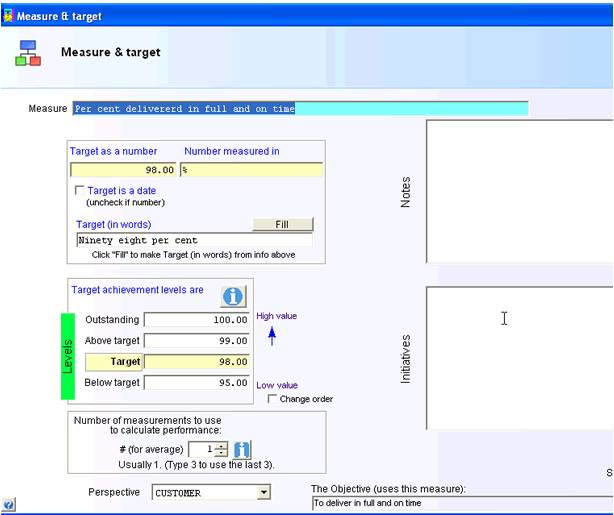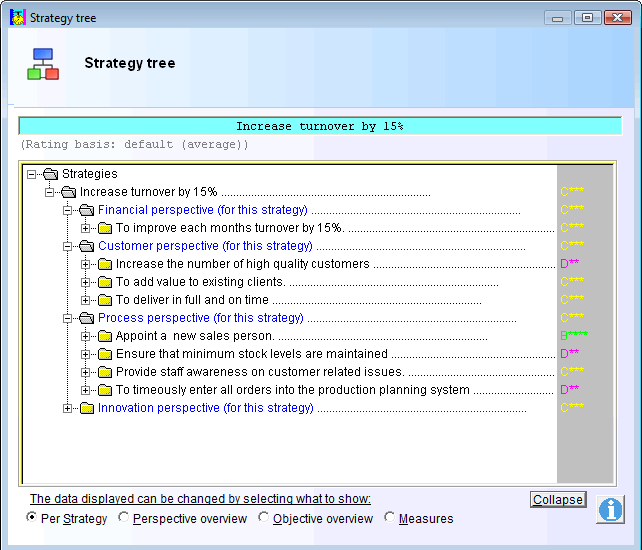The balanced scorecard is a strategic planning and management system
that is used extensively in business and industry, government, and
nonprofit organizations worldwide to align business activities to the
vision and strategy of the organization, improve internal and external
communications, and monitor organization performance against strategic
goals.
Kaplan and Norton describe the innovation of the balanced scorecard as follows:
The balanced scorecard retains traditional financial measures. But financial measures tell the story of past events, an adequate story for industrial age companies for which investments in long-term capabilities and customer relationships were not critical for success. These financial measures are inadequate, however, for guiding and evaluating the journey that information age companies must make to create future value through investment in customers, suppliers, employees, processes, technology, and innovation.
- The Learning & Growth Perspective
- The Business Process Perspective
- The Financial Perspective
- The Customer Perspective
- Does the strategy deliver the required financial result?
- What will we use to measure success - profitability, return on capital employed, economic profit, growth..
- What do the owners expect?
- What outcomes will the strategy give to our customers? We can measure new customers obtained, existing ones retained, customer satisfaction. Without customers there is no business. What will the strategy deliver for them?
- The internal processes of the organisation are often critical to the success of a strategy. The organization should do these well, improve them, work on them. Whereas the financial and customer perspective are outcomes, the process perspective is a driver. What happens here determines the outcomes achieved.
- What new processes must be done to achieve the outcomes desired?
- What skills do you need that you haven't got, or that need improvement, to achieve your long-term goals. This perspective requires thinking of people skills, and system capabilities like what other systems do you need to achieve your strategies?
- What must the organization do to ensure its long-term success? What can it do to sustain the processes so that financial outcomes continue to be achieved in the future?
- Ensure the project is Economic Value Added positive
- Identify cost drivers
- Achieve cost savings of...
- Increase stock turnover from 4 to 6
- Minimise re-work to reduce costs by...
- All new customers must be Economic Value Added positive
- Increase the number of high quality customers over the next 12 months
- Add value to existing clients
- Deliver right the first time
- Deliver on time at the customers' designated location
- Be the supplier the client considers first
- Be the preferred organisation for delivering customer support
- Identify alliance opportunities, joint ventures
- Identify existing markets at risk
- Improve availability of raw materials
- Reduce turnaround time
- Deliveries on time
- Minimize the number of rework and reject products
- Product is ready when required
- Customize products to customers requirements
- Maintain software at latest revision level
- Review of departments IT needs
- Improve system availability
- Appoint a new sales consultant
- Implement staff training program to improve the production process
- Make staff aware of the importance of customers
- Collect information on acquisition opportunities
- Identify new product opportunities
- Identify new technology advantages to our process
- Find suitable production planning software
- Obtain benchmarking data for the industry
- Develop a new technique
- Find and implement new technology to reduce expenses
- Maintain skill level of IT staff
- Provide a caring and supportive work environment for employees
- Develop and assess the implementation of an executive health program
- Develop a market intelligence system
- Document the vision, mission and strategic plan and communicate with staff and stakeholders
- Re-engineer processes
- Training on the effective use of Activity Based Costing for all managers
- Analyse customer database to find opportunities
- Identify and evaluate existing research
- Better Strategic Planning – The Balanced Scorecard provides a powerful framework for building and communicating strategy. The business model is visualised in a Strategy Map which forces managers to think about cause-and-effect relationships. The process of creating a Strategy Map ensures that consensus is reached over a set of interrelated strategic objectives. It means that performance outcomes as well as key enablers or drivers of future performance (such as the intangibles) are identified to create a complete picture of the strategy.
- Improved Strategy Communication & Execution – The fact that the strategy with all its interrelated objectives is mapped on one piece of paper allows companies to easily communicate strategy internally and externally. We have known for a long time that a picture is worth a thousand words. This ‘plan on a page’ facilities the understanding of the strategy and helps to engage staff and external stakeholders in the delivery and review of strategy. In the end it is impossible to execute a strategy that is not understood by everybody.
- Better Management Information – The Balanced Scorecard approach forces organisations to design key performance indicators for their various strategic objectives. This ensures that companies are measuring what actually matters. Research shows that companies with a BSC approach tend to report higher quality management information and gain increasing benefits from the way this information is used to guide management and decision making.
- Improved Performance Reporting – companies using a Balanced Scorecard approach tend to produce better performance reports than organisations without such a structured approach to performance management. Increasing needs and requirements for transparency can be met if companies create meaningful management reports and dashboards to communicate performance both internally and externally.
- Better Strategic Alignment – organisations with a Balanced Scorecard are able to better align their organisation with the strategic objectives. In order to execute a plan well, organisations need to ensure that all business and support units are working towards the same goals. Cascading the Balanced Scorecard into those units will help to achieve that and link strategy to operations.
- Better Organisational Alignment – well implemented Balanced Scorecards also help to align organisational processes such as budgeting, risk management and analytics with the strategic priorities. This will help to create a truly strategy focused organisation.
source: balancedscorecard.org and other sites





Thank you for sharing information about HR Software .
ReplyDeleteThis comment has been removed by the author.
ReplyDeleteThe Balanced Scorecard is a strategic management tool that helps organizations measure performance across four key perspectives: financial, customer, internal processes, and learning and growth. By integrating this approach, businesses can align their activities to long-term objectives, driving sustained success. rookiesideloader can play a role in optimizing data management and analysis for more effective performance tracking within this framework.
ReplyDelete